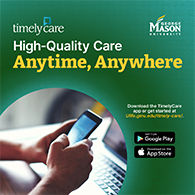By: Zachary Stroebel, Celia Miranda, Kumari Tannock, and Matthew Tiufekchiev, Mason students in the School of Business
“It takes humility to seek feedback. It takes wisdom to understand it, analyze it and appropriately act on it.” – Stephen Covey, American Educator
Feedback is incredibly important in the professional world, as it is the way we communicate how well we are doing within our roles. Whether formally at a review, or informally in a hallway, feedback is constantly happening. Despite this, it can be difficult to give and even harder to take if done improperly. Understanding how to give feedback well is crucial for success at work. Here’s how to give feedback in a professional environment.
What is Feedback?
Feedback is information given to one individual by another as a response to a person’s performance, which either shows appreciation or offers ways to improve. There are four general types of feedback that we have identified: good and bad, as well as positive and negative. Positive feedback is used to praise someone for doing well, while negative feedback is used to address shortcomings with that person. Both are necessary in the workplace, but there are good and bad ways to give them.
- Good feedback is constructive, does not attack the recipient (think ad hominem,) and offers ways to improve. It also does not inflate the recipient’s ego, or put down others in comparison.
- Bad feedback doesn’t offer any solutions, is needlessly cruel toward the recipient, and overall leaves the other person feeling overwhelmed by emotion. On the other hand, it is also feedback that has no clear message, or gives a false sense of self.
Consider the examples below, which the authors have created to better visualize the relationships between the four types of feedback:
- Good Positive: “You were able to close that huge deal recently, great job! What do you think was the deciding factor?”
- Good Negative: “I noticed that your performance wasn’t as good last quarter, perhaps we can try doing x strategy to help improve that?”
- Bad Positive: “Simply put, you are the best employee we’ve ever had. If I could fire everyone else and just make clones of you I would.”
- Bad Negative: “Your numbers slipped recently. It’s probably because you prefer to wear such tacky ties to work and don’t work hard enough.”
While the negative examples are somewhat lighthearted, we’ve all been in a situation before where someone has ruined our day with the feedback they’ve given. It is important to aim for the “good” half of the quadrant when giving your own.
General Guidelines When Giving Feedback
When giving feedback, you can follow these two overall guidelines to maximize the quality of your feedback for an individual:
Include both negative and positive points of performance in your feedback: Although it is important to include both negative qualities as well as positive, you want to be sure you don’t sandwich too much bad between the good. This may involve telling someone “Hey, your project was great. You could have added more charts, but I really liked your use of color. Again, it was great.” This will allow for better communication between the two parties, and make sure the individual receiving the feedback doesn’t get too overwhelmed. Research shows that making time to process giving feedback and paying attention to the person will result in a better response.
Be specific with your feedback: Being specific allows for the person receiving feedback to set a coherent, straightforward goal on which to focus. For example, instead of telling someone their presentation was bland, go into detail about the tone or pacing of their voice.
Giving Written Feedback
Written feedback is key to helping an individual improve his or her performance. When giving written feedback, it is essential to be as specific as possible. It is a crucial reference point and gives them a document to refer to when working on self-improvement. There are several methods for giving written feedback, including the BET and BEAR models.
The BET model is an acronym that stands for Behavior, Effects, and Thank You! This model is often used when giving positive feedback to an individual or person in a work group. It highlights what the individual did well, how their positive actions influenced the work environment, and the importance of thanking them for their impactful contribution to the group work environment.
Another model used for giving written feedback is the BEAR Model. It is an acronym that stands for Behavior, Effect, Alternative, and Result. The BEAR model is used when addressing a potential conflict that may have impacted the group negatively. The BEAR model is more impactful than the BET model because it is an honest review of what an individual could have done better in the group and how their actions negatively impacted the work environment. The alternative and result section of the BEAR model often causes a person to self-reflect and realize how his or her actions impacted others within the group.
There are several ways to give written criticism, such as using correction codes or other coded feedback like acronyms or abbreviations. Coded feedback is presented along with a key to what the codes mean. Another form of written feedback is adding comments that show highlighted areas in which a person could improve.
Giving Oral Feedback
When giving oral feedback to others, you should be keeping their best interests in mind with the goal of helping them become the best versions of themselves. First, set the tone. A good way to do this is to think of yourself receiving the feedback you’re about to give other people. Putting yourself in the position of others will help you consider their well-being in your feedback. When setting the tone, use a conversational voice, be clear when you are presenting feedback, and allow discussion while also listening attentively.
Body language is also an extremely important aspect to take into consideration when giving feedback. According to research, only 7 percent of a conversation comes from words. You want to come off as friendly and welcoming, but also prevent potential discomfort from the individual receiving feedback. Avoid body language like crossing your arms, staring, or looking away at distractions. Instead, we should be mindful of the person’s presence and make eye contact (without staring).
Practice/Strategy Feedback Scenario
Feedback in the learning environment, such as college or high school, can be very difficult to receive. There can be a lot of stress and anxiety, and students can feel vulnerable – as if they are being attacked.
A study of some New Jersey high school students found that many students either felt feedback was “something they needed to survive” or “safely non-critical comments”. Both of these examples led to no benefit for the students, and often they reviewed the feedback simply as a chore.
Although this case study was taken from high school, many of these feelings transfer over to the workplace, usually to a greater degree. When someone is reviewing your work, the stress can be immense, and it is important to learn how to be comfortable receiving feedback and how to properly give solid feedback. This case study shows that many people need to learn more about giving and receiving feedback from an early age. While doing so may seem simple, it can actually be a stressful and hard task to complete.
Many workplaces (such as Amazon), though, have adopted some new methods to practice better feedback skills, such as being customer-centric. This approach is similar to the customer is always right model, but leaves more room for discussion between the employee and customer. It is vital to have good communication between the two parties giving feedback. As this model continues to be used, it helps everyone give better, more understanding feedback to each other.
How will you use this information to improve your own feedback skills?
Additional Resources
This Forbes.com article explains how to deliver professional feedback.
This research study published by the National Library of Medicine investigates how to give and receive feedback effectively.
This National Library of Medicine article is a how-to guide to giving and receiving effective feedback.
The book Written Corrective Feedback: The Role of Learner Engagement – A Practical Approach by Alia Moser covers how to give good feedback.
Write one of these Thriving Together Series features! We’re looking for contributions on all topics related to well-being. Read other Thriving Together Series articles here and contact us at cwb@gmu.edu for guidelines. Thank you for helping our Mason community thrive together online!






















